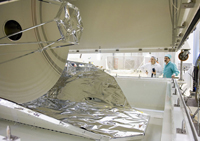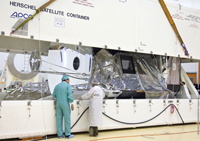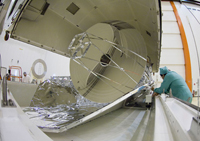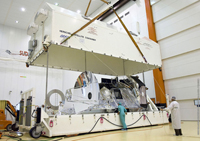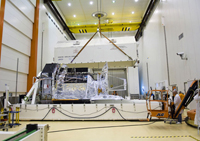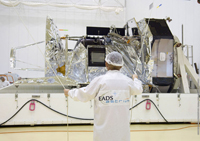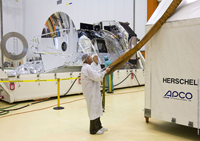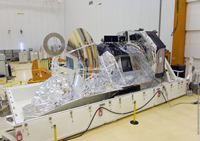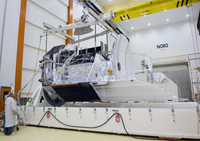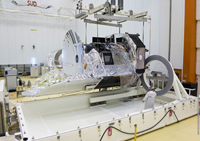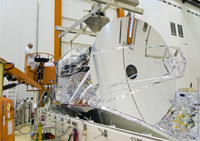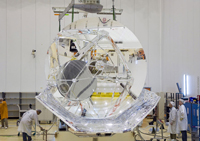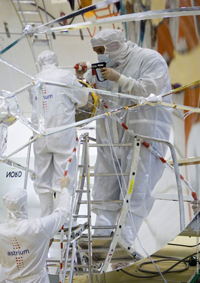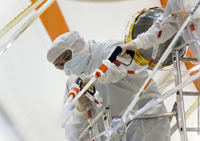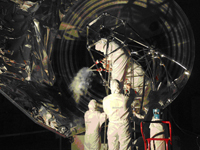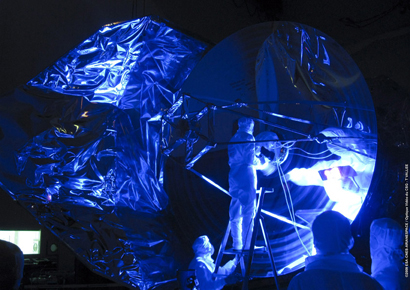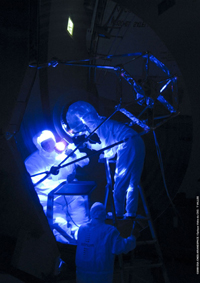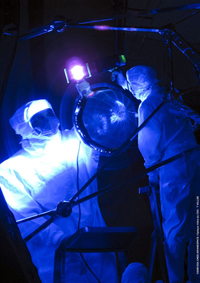Herschel spacecraft inspection and final mirror cleaning
27 February 2009
In the first few days following its arrival at CSG the Herschel spacecraft was unpacked and inspected. The first of a series of final preparations to ready the spacecraft for launch - the final cleaning of the primary and secondary mirror - was completed.
Following the arrival of the Herschel spacecraft at Rochambeau airport, French Guiana, in the early hours of 12 February the custom-built transport container carrying the spacecraft was unloaded, and transported to the Centre Spatial Guyanais (CSG) at Kourou, arriving at 10:30 am local time. The container was then moved into the airlock of the S1B building where the tarpaulin covering the container was removed and the container itself thoroughly cleaned before being moved into the large bay of the S1B clean room.
From the time of landing in Rochambeau airport until the container was opened, in the S1B clean room, on 13 February, the container was continuously flushed with dry gaseous nitrogen (GN2). This ensured that the environmental conditions under which the spacecraft was transported were optimum i.e. the atmosphere was maintained at a low humidity level and was kept clean - the overpressure between the spacecraft in the container and the exterior environment guarding against particle and molecular contamination entering.
Once the spacecraft transport container was opened the environmental parameters of the spacecraft were recorded and checked to ensure that the spacecraft had been transported in optimum conditions. Having removed the container cover a first visual inspection of the spacecraft was made.
In the meantime the horizontal lifting device was assembled and checked, the hoisting sling attached, and the hoisting brackets connected to the spacecraft which was then lifted out of the container chassis and placed on the multi-purpose trolley (MPT). (On 11 February, prior to the arrival of the spacecraft, 80 tonnes of ground-support equipment and material for the launch campaign, including the large multi purpose trolley, had arrived by Antonov cargo airplane. This had been transported by truck to CSG and unloaded and installed in readiness for the arrival of the spacecraft.)
Once on the MPT a more thorough visual inspection of all external surfaces of the spacecraft was made.
From 15 to 17 February the delicate process of the final cleaning of the 3.5-metre diameter primary telescope mirror and the smaller secondary mirror was performed to reach the good cleanliness level required for the telescope at launch. This was carried out using carbon dioxide snow (more commonly known as dry ice) which is produced by highly compressed liquid CO2 being expelled under high pressure. The snow particles, which are sprayed onto the mirror surface at an angle, vapourize and in the process carry off any contaminants which may have rested on the mirror surface. This technique is widely used also for ground-based astronomical telescopes and has the major advantage of not requiring any physical contact with the optical surface.
During the cleaning process the mirror was inspected a number of times under UV light with other illumination in the clean room turned off. This is common practice when examining the cleanliness of a surface and provides the ability to pick up particles which fluoresce under UV.
Upon completion of the final inspection of the telescope after final cleaning before launch, the spacecraft was erected into a vertical position, a protective foil was placed over the mirror and the spacecraft was then readied for the next in the series of preparatory activities: the ACU (spacecraft interface adapter, provided by Arianespace) mechanical and electrical fit check and then alignment measurements.

